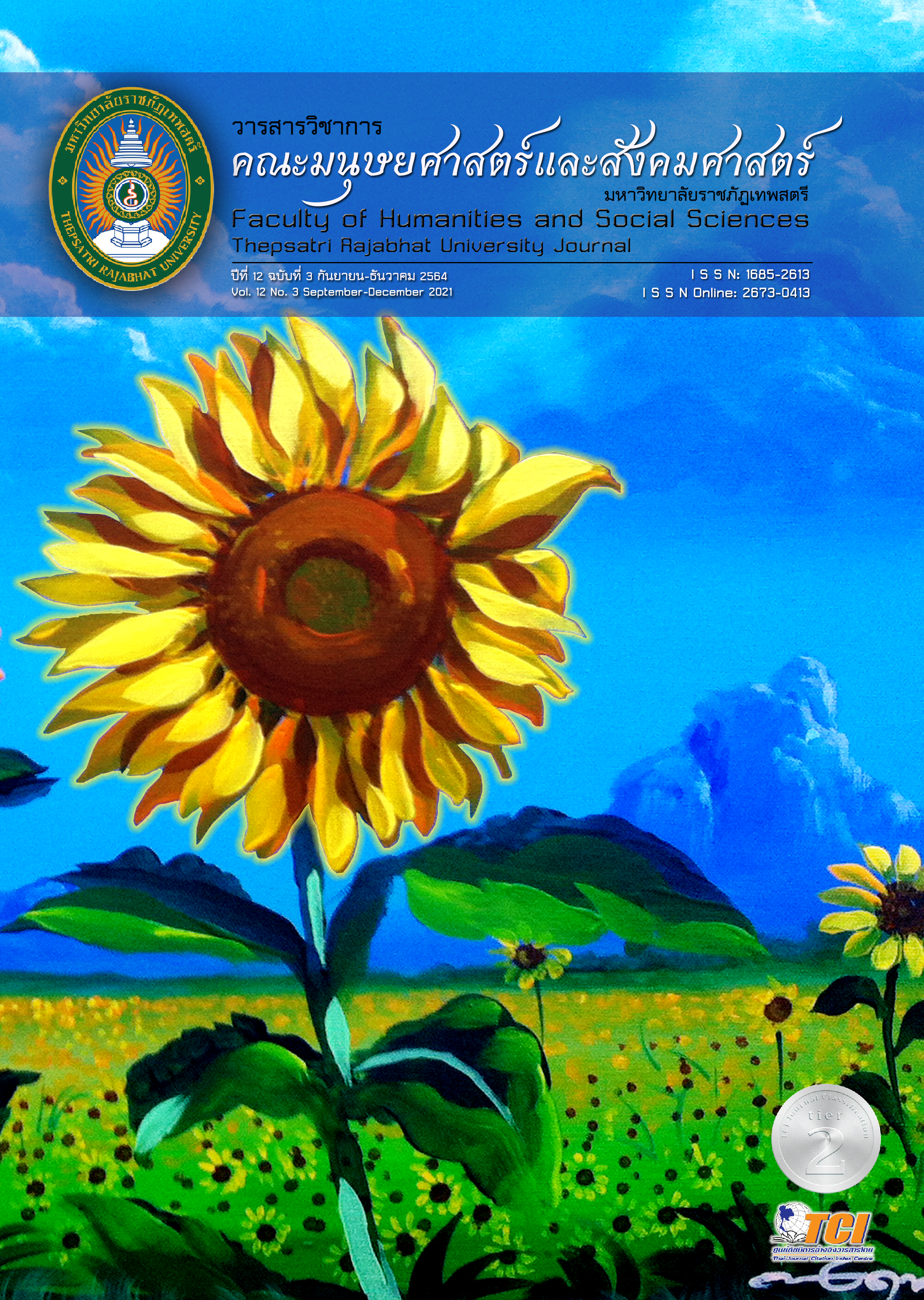A Study of English Language Learning Strategies Used by the 1st Year Undergraduate Students at Thepsatri Rajabhat University A Study of English Language Learning Strategies Used by the 1st Year Undergraduate Students at Thepsatri Rajabhat University
Main Article Content
Abstract
This study aimed to: 1) study the use of English language learning strategies by undergraduate students at Thepsatri Rajabhat University and 2) compare the differences between the English language learning strategies used by English major students and Communication Arts students. The sample for the study was 63 students who enrolled in the second semester of 2019, including 35 English major students and 28 Communication Arts students at Thepsatri Rajabhat University, by using the purposive sampling method. The research instrument was a 5-point rating scale questionnaire. The statistics used in the data analysis were frequency, mean, standard deviation, and t-test (Independent Samples). The findings revealed that the first-year undergraduate students majoring in English and Communication Arts employed all English language learning strategies at a medium level. Following an analysis of each strategy, metacognitive strategies were found to be the most often used, followed by cognitive strategies, social strategies, memory strategies, compensation strategies, and affective strategies, respectively. Furthermore, an overall comparison of English language learning strategies used by English majors and Communication Arts students indicated no significant difference between the two groups of students.
Downloads
Article Details
The content and information presented in articles published in the Academic Journal of the Faculty of Humanities and Social Sciences, Thepsatri Rajabhat University, are solely the opinions and responsibilities of the respective authors. The editorial board of the journal neither necessarily agrees with nor assumes any responsibility for such content in any manner whatsoever.
All articles, information, content, and images published in the Academic Journal of the Faculty of Humanities and Social Sciences, Thepsatri Rajabhat University, are the copyright of the journal. Any person or organization wishing to reproduce, disseminate, or otherwise utilize all or any part thereof must obtain prior permission from the Academic Journal of the Faculty of Humanities and Social Sciences, Thepsatri Rajabhat University.
References
บุญชม ศรีสะอาด. (2553). การวิจัยเบื้องต้น (พิมพ์ครั้งที่ 8). กรุงเทพฯ: สุวีริยาสาส์น.
แพรวพรรณ พริ้งพร้อม. (2552). การศึกษาการใช้กลยุทธ์การเรียนภาษาอังกฤษของนักศึกษามหาวิทยาลัย กรุงเทพ ชั้นปีที่ 1 และชั้นปีที่ 2. BU Academic Review, 8(2), 15-26.
เพ็ญวารี วิจิตรเวชไพศาล, ลัคนา ชัยศักดิ์เลิศ, และสุวิมล นภาผ่องกุล. (2559) ความแตกต่างของกลยุทธ์การเรียนรู้ระหว่างภาษาญี่ปุ่น และภาษาอังกฤษ. วารสารวิจัยราชมงคลกรุงเทพม 10(2), 93-106.
มานัส รอดซื่อ. (2559) สอนให้น้อยเรียนรู้ให้มาก (TLLM) โดยใช้ปัญหาเป็นฐานการเรียนรู้ Project Based Learning (PBL). สืบค้น ตุลาคม 23, 2021 จาก http://apr.nsru.ac.th/Act_learnn/mylife/10062014104139_3.pd
นฤมล โครตสมบัติ (2546) การศึกษาการใช้กลวิธีการเรียนภาษาอังกฤษของนักศึกษา ระดับบัณฑิตศึกษา คณะวิทยาศาสตร์ มหาวิทยาลัยมหิดลเพื่อใช้ในการเรียนรู้ภาษาอังกฤษ. วิทยานิพนธ์ปริญญามหาวชบัณฑิต มหาวิทยาลัยมหิดล
วิจารณ์ พานิช (2555). วิถีสร้างการเรียนรู้เพื่อศิษย์ในศตวรรษที่ 21. กรุงเทพฯ: มูลนิธิสดศรี-สฤษดิ์วงศ์
ศิวนนท์ นิลพาณิชย์. (2560). กลยุทธ์การเรียนรู้ภาษาอังกฤษของนักศึกษามหาวิทยาลัยชั้นปีที่ 1. วารสารวไลยอลงกรณ์ปริทัศน์ (มนุษยศาสตร์และสังคมศาสตร์), 7(2), 1-12.
สมพร โกมารทัต. (2559). การศึกษาการใช้กลยุทธ์การเรียนภาษาต่างประเทศของนักศึกษาระดับปริญญาตรีในกรุงเทพฯและปริมณฑล. รายงานผลการวิจัยของมหาวิทยาลัยธุรกิจบัณฑิตย์. (หน้า 1-97)กรุงเทพฯ: มหาวิทยาลัยธุรกิจบัณฑิตย์.
อรุณี อรุณเรือง, รพีพรรณ สุฐาปัญณกุล, และภาวิณี อุ่นวัฒนา. (2560) กลวิธีการเรียนภาษาอังกฤษของนักศึกษา ชั้นปีที่ 2 ระหว่างสาขาวิชาการท่องเที่ยวการโรงแรม ภาษาอังกฤษเพื่อการสื่อสารสากล. การประชุมวิชาการ มหาวิทยาลัยเทคโนโลยีราชมงคล ครั้งที่ 9 (9 th RMUTNC) และการประชุมวิชาการนานาชาติ มหาวิทยาลัยเทคโนโลยีราชมงคล ครั้งที่ 8 (8 th RMUTIC). 8 สิงหาคม 2560, (หน้า 37-45) นนทบุรี: มหาวิทยาลัยเทคโนโลยีราชมงคล
Brown, A. L., & Palincsar, A. S. (1982). Inducing strategies learning from texts by means of informed, self-control training. Topics in Learning and Learning Disabilities, 2(1), 1-17.
Iamla-ong, H. (2014). Language learning problems and language learning strategies of MFU students. MFU Connation: Journal of Humanities and Social Sciences, 3(1), 54-86.
Kunasaraphan, K. (2015). English learning strategy and proficiency level of the first year students. PROCEDIA SOCIAL AND BEHAVIORAL SCIENCES, 197, 1853-1858.
McGroatry, M., & Oxford, R. (1990). Language Learning Strategies: An introduction and Two related studies. In Padilla, A.M. et al. (Eds.). Foreign Language Education: Issues and Strategies, (56-74). CA: SAGE Publications.
Naiman, N., Frohlich, M., Stern, H.H, &Todesco, A. (1978) The good language learner: Research in Education Series 7. Toronto, Ontario: Institute for Studies in Education
O’ Malley, J.M. (1985). Learning Strategy Applications with Students of English as a Second language. TESOL Quarterly, 19(13), 557-584.
O’Malley, J.M. & Chamot, A.U. (1990). Learning strategies in second language acquisition. Cambridge: Cambridge University Press.
Oxford, R. L (1990). Language learning strategies: What every teacher should know. New York: Newbury House.
Oxford, R. L. & Nyikos, M. (1989). Variables affecting choice of language learning Strategies by university students. Modern Language Journal, 73(3), 291-300.
Phillips, V. (1991). A look at learner strategy use and ESL proficiency. CATESOL Journal, November, 57-67.
Politzer, R. L., & McGroarty, M. (1985). An exploratory study of learning behaviors and their relationship to gains in linguistic and communicative competence. Tesol Quarterly, 19(1), 103-123.
Price, G. (1978). Research on learning style with suggestion for teacher experimentation. Englewood cliffs. New Jersey: Prentice Hall.
Rubin, J. (1981). Study of Cognitive Processes in Second Language Learning. Applied Linguistics, 11, 117-123.
Santikarn. B. (2014) The Use of Language Learning Strategies: A Case Study of Undergraduate Students in a Private University. Journal of Language and Communication, 19 (21), 55-72.


